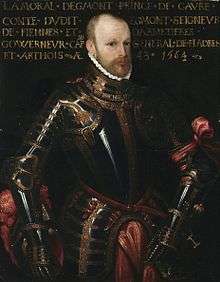Egmont (Beethoven)
 |
|
| Problems playing this file? See media help. | |
Egmont, Op. 84, by Ludwig van Beethoven, is a set of incidental music pieces for the 1787 play of the same name by Johann Wolfgang von Goethe.[1] It consists of an overture followed by a sequence of nine pieces for soprano, male narrator and full symphony orchestra. (The male narrator is optional; he is not used in the play and does not appear in all recordings of the complete incidental music.) Beethoven wrote it between October 1809 and June 1810, and it was premiered on 15 June 1810.
The subject of the music and dramatic narrative is the life and heroism of a 16th-century Dutch nobleman, the Count of Egmont. It was composed during the period of the Napoleonic Wars, at a time when the French Empire had extended its domination over most of Europe. Beethoven had famously expressed his great outrage over Napoleon Bonaparte's decision to crown himself Emperor in 1804, furiously scratching out his name in the dedication of the Eroica Symphony. In the music for Egmont, Beethoven expressed his own political concerns through the exaltation of the heroic sacrifice of a man condemned to death for having taken a valiant stand against oppression. The Overture later became an unofficial anthem of the 1956 Hungarian revolution.
Beethoven composed Klärchen’s songs, "Die Trommel gerühret" ("The drum is a-stirring") and "Freudvoll und leidvoll" ("Joyful and woeful"), with the Austrian actress Antonie Adamberger specifically in mind. She would later repeatedly and enthusiastically recall her collaboration with him.[2]
The music was greeted with eulogistic praise, in particular by E.T.A. Hoffmann for its poetry, and Goethe himself declared that Beethoven had expressed his intentions with "a remarkable genius."
The overture, powerful and expressive, is one of the last works of his middle period; it has become as famous a composition as the Coriolan Overture, and is in a similar style to the Fifth Symphony, which he had completed two years earlier.
Outline of sections
The incidental music comprises the following sections, among which the overture, the lieder Die Trommel gerühret, Freudvoll und leidvoll and Klärchens Tod are particularly well-known:
- Overture: Sostenuto, ma non troppo – Allegro
- Lied: "Die Trommel gerühret"
- Entracte: Andante
- Entracte: Larghetto
- Lied: "Freudvoll und leidvoll"
- Entracte: Allegro – Marcia
- Entracte: Poco sostenuto e risoluto
- Klärchens Tod
- Melodram: "Süßer Schlaf"
- Siegessymphonie (symphony of victory): Allegro con brio
Cultural influences
Short Film Palme d'Or winning Hungarian film Overture by János Vadász uses the complete Egmont Overture as the soundtrack for a series of images featuring a hatching bird, referencing the rebellious nature of Egmont fighting for freedom despite all barriers. The film, nominated for Academy Award for Best Documentary (Short Subject) is one of the most influential short films in film history and is described as "among the most ingenious pairings of music and image in the history of the festival."[3]
References
- ↑ Wigmore, Richard. "A meeting of genius: Beethoven and Goethe, July 1812". Gramophone. Haymarket. Retrieved 6 July 2012.
- ↑ Beethoven aus der Sicht seiner Zeitgenossen, edited by Klaus Martin Kopitz and Rainer Cadenbach, Munich 2009, Vol. 1, pp. 3–5
- ↑ http://www.film.com/movies/best-cannes-short-films
External links
- Egmont: Scores at the International Music Score Library Project
- Internet Archive: Free Download: Beethoven: Egmont Overture on the Internet Archive
